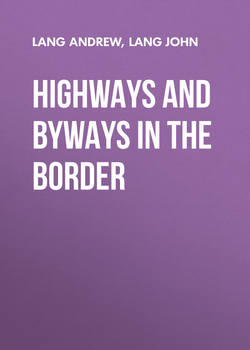Highways and Byways in the Border

Реклама. ООО «ЛитРес», ИНН: 7719571260.
Оглавление
Lang Andrew. Highways and Byways in the Border
PREFACE
CHAPTER I BERWICK, TWEED, WHITADDER
CHAPTER II BLACKADDER, NORHAM, FLORDEN, COLDSTREAM, WARR, AND THE EDEN
CHAPTER III KELSO, ROXBURGH, TEVIOT, KALE, AND OXNAM
CHAPTER IV JEDBURGH, AND THE JED
CHAPTER V JED (continued), FERNIHIRST, RAID OK THE REDESWIRE, OTTERBURNE
CHAPTER VI ALE, RULE WATER, TEVIOT, HAWICK
JOHNIE ARMSTRANG
CHAPTER VII TWEED, ST. BOSWELLS, DRYBURGH, NEWSTEAD, AND THE LEADER
CHAPTER VIII ST. BOSWELLS GREEN, MELROSE, DARNICK, ABBOTSFORD, AND THE ELLWAND
CHAPTER IX GALASHIELS AND THE GALA, LINDFAN
CHAPTER X SELKIRK
CHAPTER XI THE ETTRICK, CARTERHAUGH, OAKWOOD, TUSHIELAW, THIRLESTANE, ETTRICK KIRK
CHAPTER XII YARROW
CHAPTER XIII UPPER TWEED, YAIR, FAIRNILEE, ASHIESTEEL, EUBANK, INNERLEITHEN, TRAQUAIR
CHAPTER XIV PEEBLES, NEIDPATH, MANOR, LYNE, DRUMMELZIER, DAWYCK
CHAPTER XV BROUGHTON, TWEEDSMUIR, TALLA, GAMESHOPE, TWEED'S WELL
CHAPTER XVI LIDDESDALE, HERMITAGE, CASTLETON
CHAPTER XVII KERSHOPEFOOT, CARLISLE CASTLE, SOLWAY MOSS
CHAPTER XVIII BEWCASTLE, LIDDEL MOAT, NETHERBY, KIRK ANDREWS, GILNOCKIE, LANGHOLM
Отрывок из книги
"My work seeks digressions," says Herodotus, and mine has already wandered far north of the old Border line of Tweed on the east, and Esk on the western marches, far into what was once the great forest of Ettrick, and now is mainly pasture land, pastorum loca vasta. In the old days of the Catrail and the hill forts this territory, "where victual never grew," must have been more thickly populated than it has been in historic times.
We may best penetrate it by following the ancient natural tracks, by the sides of Tweed and its tributaries. We cross the picturesque bridge of Tweed at Berwick to the town which first became part of the kingdom of Scotland, when Malcolm II, at Carham fight, won Lothian from Northumbria. That was in 1018, nine centuries agone. Thenceforward Berwick was one of the four most important places of Scottish trade; the Scots held it while they might, the English took it when they could; the place changed hands several times, to the infinite distress of a people inured to siege and sack. They must have endured much when Malcolm mastered it; and again, in 1172, when Richard de Lacy and Humphrey de Bohun, at war with William the Lion, burned the town. William, after he inadvertently, in a morning mist, charged the whole English army at Alnwick, and was captured, surrendered Berwick to England, by the Treaty of Falaise, when he did homage for his whole kingdom. The English strongly fortified the place, though the fragments of the girdling wall near the railway station, are, I presume, less ancient than the end of the twelfth century. William bought all back again from the crusading Richard of the Lion Heart: the two kings were "well matched for a pair of lions," but William the Lion was old by this time.
.....
Our ancestors of a hundred years ago were not to be "lippened to" where ecclesiastical remains were concerned. They had what amounted to a passion for pulling down anything that was old, and where they did not pull down, they generally covered with hideous plaster any inside wall or ornamental work, which to them perhaps might savour of "papistry." Parish ministers, even late in the eighteenth and early in the nineteenth centuries, appear to have taken no interest in those beautiful Norman remains, numerous fragments of which even now exist in Berwickshire; of all those ministers who compiled the old Statistical Account of this county, but one or two make any mention of such things. One fears, indeed, that to some of those reverend gentlemen, or to others like them of later date, we are indebted for the destruction of priceless relics of the past. At Duns, for instance, as late as 1874 the original chancel of an old Norman church was pulled down by order of the incumbent, "to improve the church-yard." Then, as already mentioned, there is Bunkle, an instance of very early Norman work, pulled down in 1820. At Chirnside, the tower of its Norman church was sacrificed in 1750. though great part of the old church walls remain; in the south side is a Norman doorway six feet ten inches in height to the lintel and two feet ten and three-quarter inches wide. Of Edrom church, a very beautiful Norman doorway, said to be "the finest of its style in Scotland," has been preserved, entirely owing, apparently, to the fact that it had been made the entrance to a burial vault. At Legerwood, near Earlstoun, where stands the chancel of a Norman church, the arch is still entire but is defaced with plaster. Berwickshire, however, is not the only part of the Border where such things have been done.
Higher up Tweed, at Stobo in Peeblesshire, there is an interesting old church of Norman structure, with sixteenth and seventeenth century alterations; roof and interior fittings are modern, and the building is still used as the Parish Church. Sixteenth and seventeenth century alterations have now at least age to commend them, but it is difficult to see what plea can be advanced for some of those of comparatively recent date. According to "Ecclesiastical Architecture of Scotland," the most serious injury inflicted on the building was the entire destruction of the Norman chancel arch, in order to insert a modern pointed one, at the restoration of the church in 1868.
.....